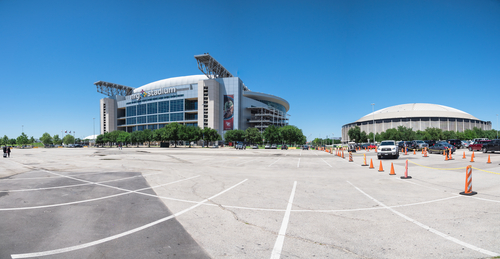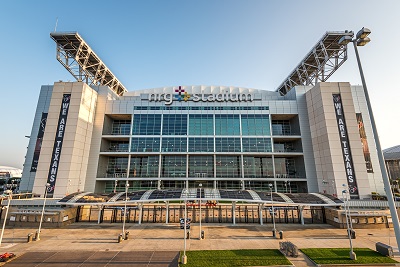NRG Stadium in Houston, Texas, will be the home of the ultimate thrill of victory and the agony of defeat for the remaining four teams of March Madness, as the NCAA Basketball Men’s Final Four and championship games will be held there April 1–3, 2023. It’s a great way to get excited as this large facility celebrates its 20th anniversary!

Whether you’ll be lucky enough to watch the exciting action of the Final Four games from a stadium seat or choose the comfort of your home, it’s likely you are rooting for your favorite college basketball team to cut down the nets and be crowned 2023 national champion. While the players on the floor are where the action is, facilities professionals around the world will be focused on the star of the show: NRG Stadium.
What You Need to Know
- Name: NRG Stadium
- Location: Houston, Texas
- Owner: Harris County Sports and Convention Corporation (HCSCC)
- Cost: $449 million (originally $367 million, but the cost increased to cover extra restrooms, more parking, landscaping, and additional concession areas)
- Seating capacity: 72,220 seats, with 196 suites
- Size (total area): 1.9 million square feet (sq ft)
- Size (playing surface): 97,000 sq ft
- Concourse levels: 4
- Key building materials: 17,274 tons of steel; 160,000 cubic yards of concrete; and 423 tons of bolts
- Notable feature: Retractable roof
- Year opened: 2002 (broke ground in 2000)
- Renovations: 2008, 2013, 2016
- Primary use: Houston Texans (NFL), Houston Livestock Show and Rodeo Show, TaxAct Texas Bowl
- Other uses: Other live sporting events, concerts, live shows, and conferences
What’s in a Name?
NRG Stadium is named after energy company NRG Energy and was formerly known as Reliant Stadium after Reliant Energy. NRG Energy bought Reliant Energy in 2009 and purchased naming rights for $300 million for 32 years. The facility embarked on a major process in 2014 to change signs, including ones for streets and highways, in time for the football season.
The Roof Is the Story
NRG Stadium features a retractable roof, which was designed by Populous, formerly known as HOK Sport, that allows the facility to host events in a variety of weather conditions. The roof is made of two massive panels that can open and close independently of each other at the 50-yard line. When the roof is fully retracted, the panels are above each end zone.

But just how do the panels slide open and close? There are 10 parallel, tri-chord trusses that ride on 2 parallel rails that are supported by a 675-ft-long super-truss.
The stadium press box has a computer that controls the roof operation and shows live images of the travel path of each roof panel, as well as live images from all roof components. Moving at a top speed of 35 ft per minute, the roof can be opened or closed in 7 minutes.
NRG Stadium was the first NFL stadium to have a retractable roof, which can allow the stadium to be configured as a 125,000-sq-ft space for general sessions and shows the facility’s commitment to innovation and flexibility.
Renovations & Technology
Facilities professionals know that every building needs to keep up with the times through upgrades, whether planned or unplanned, in the event of weather. For example, a 2008 renovation was necessary to fix the retractable roof and interior damage caused by Hurricane Ike.
Also, a 2013 renovation included two giant screens, 14,549 sq ft each, behind each end and allowed the stadium to earn a global record. This prepared the facility for Super Bowl XXXVII in 2014, when the New England Patriots beat the Carolina Panthers 32–29.
Moreover, a $50 million renovation was needed in 2016 to prepare it for the 2017 Super Bowl LI and included a stadium-wide Wi-Fi system, a new synthetic turf, suite improvements, and upgraded food offerings. That Super Bowl also featured the New England Patriots, who beat the Atlanta Falcons 34–28.
Just One Piece of the Puzzle
NRG Stadium is only one piece of a large 350-acre complex called NRG Park, which hosts over 500 events each year. The park includes a number of other venues, including two convention centers, an arena, a sports stadium, and huge outdoor spaces.

- NRG Astrodome (opened 1965). While there have been plans to revitalize this former 1,000,000-sq-ft sports stadium that was once home to the Houston Astros baseball team, according to Texas Monthly, the stadium has been void of any events since 2002 because it’s both “too expensive to renovate and too beloved to tear down,” but it did serve as a temporary shelter for Hurricane Katrina evacuees in 2005. ABC13 reports that it costs $400,000 a year for maintenance and insurance for the facility. Proposals to reuse the center have included ideas for an event space, a luxury hotel, a movie studio, a convention center, and a city park, but none made it off the drawing board.
- NRG Arena (1974). This 349,000-sq-ft building has exhibit space that can divide into 4 halls; an 8,000-seat arena; and a 2,000-seat pavilion, and it serves as the primary horse competition facility for the Houston Livestock Show and Rodeo. It was formerly the home of the Houston Hotshots, the city’s former indoor soccer team, as well as the Houston Comets, the city’s WNBA team, and the Houston Lightning, an indoor football team.
- NRG Center (2002). These 2 major conference centers have a total of 1.4 million sq ft and over 706,000 sq ft of contiguous single-level exhibit space and can divide into 11 separate halls. There are also 59 meeting rooms and over 150,000 sq ft of registration space. Previous events held here include the Houston Auto Show, the Barrett-Jackson Collector Car Auction, and the H-Town Sneaker Summit.
- NRG Park outdoor spaces. This is one of the world’s largest parking lots, with 26,000 spaces in 8 color-coded sections from 275,000 sq ft to 1.8 million sq ft, which can be transformed to host outdoor music festivals; sporting events like car races, runs, and 5Ks; and ride-and-drives.
Sustainability
Owned by NRG Energy, NRG Stadium shows the company’s commitment to sustainability in a variety of ways. For example, the company installed nearly 600 solar panels atop pedestrian bridges and around the stadium, as well as several electric vehicle charging stations.

“One of the reasons we believe having our name on a stadium like this is we want people to realize how affordable and reliable renewable energy solutions can be,” Pat Hammond, director of media relations at NRG, told AccuWeather.
Notably, NRG Stadium was one of the first stadiums in the United States to illuminate its field with an array of high-efficiency light emitting diodes (LEDs). The system features more than 65,000 LEDs mounted in 480 optically enhanced luminaries. It draws 337 kW at full power, 60 percent less than the stadium’s previous light system.
According to an NRG Park brochure, the larger park complex has also implemented the following sustainability measures:
- A Building Automated System (BAS) to maximize energy use throughout the park;
- Orbio 5000-Sc, a chemical-free cleaning solution generated on-site;
- 250 recycling bins to collect cardboard, glass, and plastic;
- 30 acres of green space, with 2,200 trees and 2 permanent water features;
- 16 NRG Stadium matrix boxes, which have thermal-controlled fan switches; and
- Motion sensor technology in individual offices and restrooms to conserve utilities.
Vertical Transportation
There’s no doubt that facility managers spend a great deal of time maintaining vertical transportation systems. In addition to regular inspections, these systems have to be fixed promptly when they break down to help accommodate the large number of people at NRG Stadium and the surrounding NRG Park.
NRG Stadium specifically features the following vertical transportation options:
- 15 service elevators
- 2 freight elevators
- 20 escalators
- 4 public stairwells
- 4 public ramps
Safety & Security
Keeping the visitors of the NRG Park campus safe and secure during their event experience is of the utmost importance. According to Pitchfork, any NRG Park event with 6,000 attendees requires an on-site unified command center staffed by the Houston Police Department, the Houston Fire Department (HFD), the Harris County Sheriff’s Office, the Harris County Fire Marshal’s Office, the Mayor’s Office of Special Events, NRG Park, and the event organizer.

Specifically, HFD must provide site security and medical plans, review and approve event capacity, and communicate with event organizers to make sure safety, medical, and site planning requirements are met.
These safety requirements come after the 2021 Astroworld tragedy at NRG Park that caused 10 deaths and about 300 injuries when a crowd of 50,000 quickly descended toward the stage at an outside music festival.
One of a Kind
Sustainability, security, several key renovations, its retractable roof, and its massive size make NRG Stadium a venue like no other. Playing in a facility this enormous is quite the treat for the NCAA Men’s Final Four this year. This facility hosted both the 2011 and the 2016 NCAA Men’s Final Four, and the Connecticut Huskies won the championship here in 2011, beating the Butler Bulldogs, while the Villanova Wildcats were the champs back in 2016, beating the North Carolina Tar Heels.
Additional information and details on NRG Stadium, including comprehensive floor plans, specs, and a photo gallery, can be found by clicking here.
